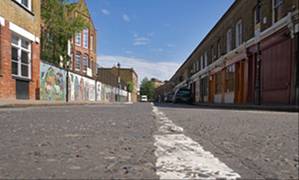Whenever there’s a line of cars backing up on the road, my guess is usually right – it’s a cop managing a traffic junction ahead instead of the traffic lights or the timers of the traffic lights set badly to treat light traffic gets just the same as heavy. The cop’s no-thanks contribution comes from his long persistence with a flow before he turns on the next.
Here’s a lightly edited excerpt from an article by Simon Jenkins appearing in The Guardian of 4th Feb 16. A case for dismantling authority! Well, that was stretching the point a little too far, admittedly. An interesting experiment in social behavior that runs counter-intuitive for many of us, nevertheless reportedly successful in outcomes. Here we go:
“
The removal of road markings is to be celebrated.
We are safer without them

Sensational news. The government is starting to remove white lines from the middle of roads in parts of the UK. It is doing so to reduce accidents and save lives…
Research has shown that removing white lines induces uncertainty and thus cuts vehicle speeds by 13%. This has been the case on London’s A22, A23 and A100. Pilot schemes are also in place in Wiltshire, Derby, and round the Queen’s house at Sandringham.
Behind this demarking lies the concept of “shared space” and “naked streets”, developed in the 1990s by the late Dutch engineer, Hans Monderman. He held that traffic was safest when road users were “self-policing” and streets were cleared of controlling clutter. His innovations, now adopted in some 400 towns across Europe, have led to dramatic falls in accidents.
Monderman’s principle is that freedom to assess risk for ourselves is what makes us safer. Rules, controls, signs, traffic lights all reduce our awareness of our surroundings and thus our sense of danger. On roads, he said: “When you don’t exactly know who has right of way, you tend to seek eye contact with other road users. You automatically reduce your speed … and take greater care.”
Monderman’s British apostle, John Adams of University College, London…has figures to prove that countries… that do not require motorbike helmets have fewer biking accidents than those that do.
The most dangerous place on a road is at traffic lights. Almost half the accidents in most cities occur at lights. This is due not just to war between “amber gamblers” and reckless cyclists. A crossing is where everyone should be watching everyone else, but everyone is watching the lights. They are awaiting orders. When given them, they assume all is safe and crash on.
Traffic engineers, who maim and kill us with regulations, lights and paint pots, merely go on dreaming up ever more.
Last October the Yorkshire town of Beverley suffered a failure of 42 traffic lights and was amazed when traffic moved more smoothly. In Somerset the traffic campaigner Martin Cassini secured a 50% improvement in traffic flow by persuading Portishead to turn off its traffic lights. They stayed off.
The same goes for…the one-way street and the cycle lane. A recent US study found that making streets two-way halved accidents, shortened journeys and reduced pollution…a 2014 study suggested that painting roads made cycling more dangerous.
Monderman…saw a symptom of a deeper ailment. “We’re losing our capacity for socially responsible behaviour. The greater the number of prescriptions, the more people’s sense of personal responsibility dwindles,” he said. It was this loss of responsibility that yielded the paradox that ever more intrusive safety and security actually make us less safe. Traffic is the most visible manifestation of that.
“
While it is difficult to argue against data, it seems to fly in the face of the premise: systems, processes and technology take the hassles and risks out of our lives. Don’t we need all the protection possible from that one nut who screws it up inadvertently, irresponsibly or irrationally?
End
Source: theguardian.com/commentisfree/2016/feb/04/removal-road-markings-safer-fewer-accidents-drivers